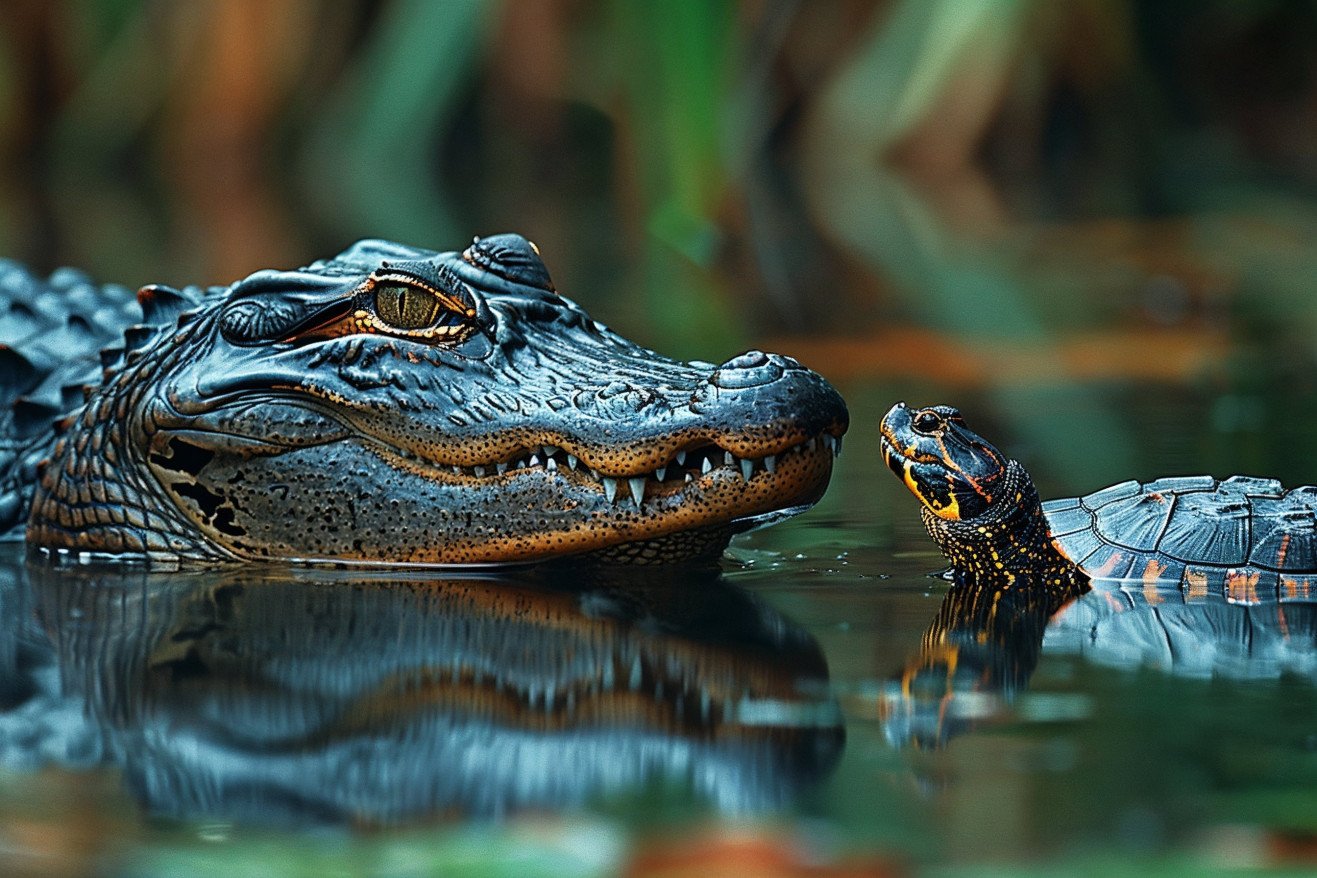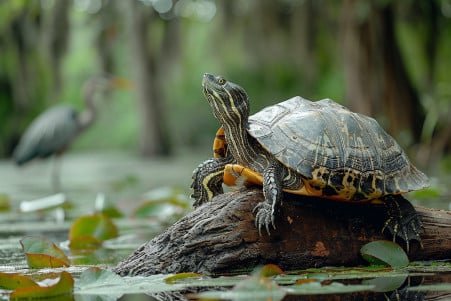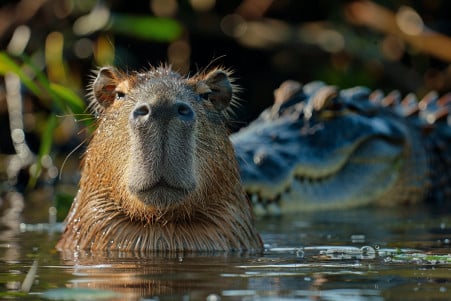Do Alligators Eat Turtles? Insights from Ecological Research
18 February 2024 • Updated 16 February 2024

This statement suggests a natural interaction between the predator’s abilities and the prey’s defenses, which piques curiosity. Alligators do eat turtles as part of their diet. Their powerful jaws can crush a turtle’s shell, although smaller turtles are more commonly targeted. As opportunistic feeders, alligators prey on turtles in their aquatic habitats when they are available.
We will delve into a mix of ecological, biological, and conservation-focused studies to unravel the complex dynamics between alligator predation and turtle survival. We will examine the dietary habits of alligators, the evolutionary defense mechanisms of turtles, and the broader ecological implications of their interactions. By synthesizing insights from these diverse research perspectives, we aim to provide a comprehensive understanding of the intriguing predator-prey relationships within aquatic ecosystems.
Do alligators eat turtles?
Alligator Feeding Behaviors and Their Taste for Turtles
While American alligators have a wide-ranging diet, it’s worth exploring where turtles fall on the list of things that alligators like to eat. These apex predators are opportunistic eaters and will eat a range of animals, including fish (which make up 80% of their diet), as well as birds, snakes, and mammals, according to TurtleHolic.
Turtles, which are common in freshwater environments, are also on the menu. Turtles’ large size and slow speed make them an easy target for alligators.
Alligators have a bite that can exert 300 pounds of pressure per square inch, which means that they can easily bite through the hard shell of a turtle. While turtles aren’t a main source of food for alligators, they are eaten often enough that they are considered a regular part of the alligator’s diet.
There have been many observations of alligators preying on or eating turtles in the wild, especially in the ponds and swamps where both animals live. This is backed up by the National Wildlife Federation, which notes that alligators are adaptable and are considered a keystone species because they help maintain the balance of their ecosystems.
While turtles are only a small part of the alligator’s diet, their relationship with alligators is a great example of the complex and fascinating predator-prey relationships that happen in aquatic environments.
Turtles’ Protective Shell and Evasion Techniques
Turtles have developed a number of defense mechanisms over millions of years, but none are as well-known as the shell—a hard, bony structure that has evolved to become an almost impenetrable fortress guarding the animal’s most important organs.
An article from the National Wildlife Federation on turtle biology explains that the shell is made up of an upper carapace and a lower plastron, which are made up of bony plates and, in many species, covered in horny shields. This design has proven to be a formidable defense against many predators, including alligators.
In addition to their physical defenses, turtles have also developed a number of behavioral strategies to avoid predators. While some species can pull their heads and legs completely into their shells, others secrete a foul-smelling musk that deters predators, according to Pets on Mom.com.
When it comes to alligator predation, documented cases have proven that the shells of turtles are up to the task. One dramatic example reported by The Daily Mail shows a turtle’s shell standing up to a 15-minute alligator attack, proving that the shell is incredibly strong and effective.
Over millions of years of evolution, turtles have perfected these defenses, which not only protect them from the powerful jaws of alligators but also help them survive in the many different and often dangerous waterways they call home.
The Armor of the Ages: The Evolution of the Turtle Shell
The origin of the turtle shell is one of the most extraordinary events in the history of vertebrate evolution and dates back to approximately 260 million years ago.
A paper in Scientific Reports that examines the microanatomy of the stem-turtle Pappochelys rosinae provides evidence for the origin of the turtle shell, suggesting that the ribs of stem-turtles like Pappochelys flattened and expanded, laying the foundation for the protective carapace that is so familiar today.
This process is further detailed by Smithsonian Magazine, which describes the half-shelled Odontochelys as a key transitional species that had a fully-formed plastron but no carapace, demonstrating the step-by-step construction of the turtle shell.
The turtle shell’s unique structure consists of bony plates fused to the ribs and covered by keratinous scutes. This provides a formidable defense against predators like alligators.
According to a paper in ScienceDirect, the evolution of the turtle shell is the result of the fusion of the ribs and vertebrae, a process unique to turtles and one of the most complicated in the animal kingdom.
Not only does the turtle shell protect the animal, but it also provides the support that the turtle needs for its muscles and respiratory system. This shows how the turtle shell is a prime example of an evolutionary adaptation with multiple functions.
While the evolutionary battle between turtle shells and alligator jaws has persisted for millions of years, the durability of the turtle shell is a demonstration of the strength of evolution and how it has preserved the equilibrium between predator and prey in the world’s waterways.
Understanding the Impacts of Alligator Predation on Turtle Populations
Alligator predation is a natural factor that impacts turtle populations and may even shape entire ecosystems. As apex predators, alligators influence not only their direct prey but also the broader community. An investigation in Ecosystems determined that alligators have indirect impacts on their prey, including turtles, through their environmental modifications and contributions to ecosystem dynamics. This demonstrates the complex relationships within food webs and the significance of predator-prey relationships.
The conservation of turtle species is an increasingly important topic, especially given the recent discovery that turtles with distinct traits are more likely to be at risk of extinction, according to a study by researchers at the University of Oxford that was published in Nature Communications.
Alligator predation, in addition to habitat loss and exposure to environmental pollutants, is one of the factors that needs to be addressed in the conservation of these distinct groups of reptiles.
A study by SREL Herpetology on turtles and alligators showed that both longevity and trophic level are important factors in determining the levels of contaminants in these animals. This is important because it helps to determine the potential long-term risks of exposure that could impact turtles and alligators, and it has implications for wildlife management and remediation.
This knowledge is important for maintaining the health of ecosystems and developing management plans that take into account the delicate balance between these ancient reptiles.
Alligators Are a Keystone Species
In biology, a keystone species is one that has a disproportionately large impact on its environment relative to its abundance. The American alligator is a classic example of this phenomenon, as it has a major influence on the southeastern United States, especially the Everglades.
According to Everglades National Park, alligators help create peat, which is critical to the wetland ecosystem. They also dig “alligator holes” that store water during the dry season, which is important for many species.
The fact that alligators eat turtles is another way that alligators are a keystone species. By eating turtles, alligators help control the turtle population, which in turn affects the vegetation and other animal species in the ecosystem. A report by Cincinnati Parks explained that the alligator’s varied diet is important for maintaining the balance of wildlife populations and the structure of wetlands.
The importance of the alligator as a keystone species has been taken into account in conservation efforts. For example, the Comprehensive Everglades Restoration Plan is working to restore habitats so that alligators—and the many other species that depend on them, including turtles—can continue to survive. This shows how species in aquatic ecosystems are interconnected.
The Ballet of the Swamp: Alligators, Turtles, and the Dance of Predator and Prey
In the watery stages of the swamp and marsh, alligators are the opportunistic stars, while turtles play the role of prey in this ancient ballet. The diet of alligators is a reflection of their environment, and turtles are just one of many items on the menu at the buffet of nature.
The hunting ability of these powerful reptiles is only matched by the defensive abilities of turtles, especially their shells, which demonstrate millions of years of evolution.
The ecological relationship between alligators and turtles is important because every interaction has a domino effect on the rest of the ecosystem. These moments of predation are not only about survival but also about the health and balance of the larger wetland ecosystem. Conservationists are working to make sure this balance is maintained so that alligators can continue to be keystone species and turtles can continue to coexist with them.
In the end, the relationship between alligators and turtles is a compelling indication of the complexity and resilience of nature. It is a relationship that we must continue to respect and study in order to maintain the delicate balance that supports the rich diversity of life in the world’s precious aquatic ecosystems.


